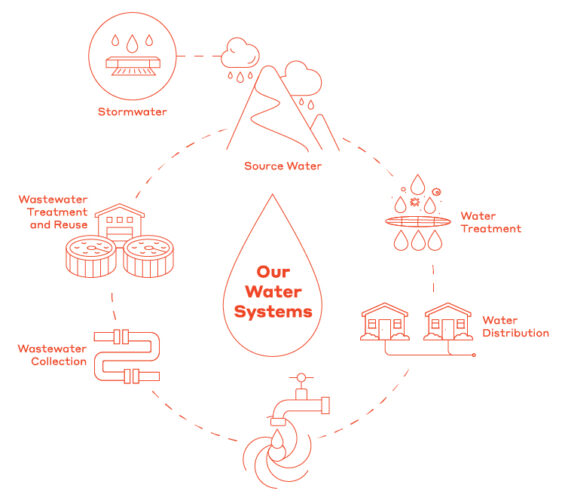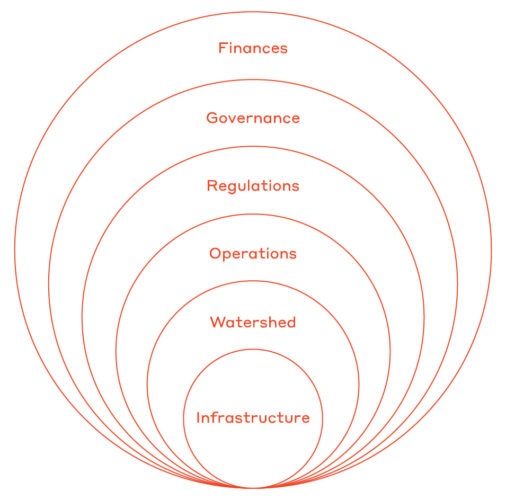From source to tap and sink to watershed. Managing water risks with a One Water approach.
As drinking water, wastewater and stormwater systems have evolved with the development of cities, they have become more complex and specialized, while also becoming siloed — typically being managed independently from each other. A One Water approach can cooperatively and holistically manage water systems by connecting the siloed components.
Let’s consider a typical city. Every day, water flows from a water source, through a treatment system producing clean drinking water, then through pipes hidden underground to deliver water into homes. Of course, this water must also have a way out — a system of wastewater pipes, also hidden, that removes used water from homes, delivering it to a treatment system, and back to the environment – usually a river, lake or ocean. There is yet another system to consider when it comes to water removal. The way cities have been built has made the surface impervious, so rain no longer seeps into the ground. Therefore, there is a third system, still mostly hidden, that removes the stormwater from our cities to prevent flooding and sends it to the nearest water body.
RISKS TO OUR WATER SYSTEMS SHOULD BE LOOKED AT USING A ONE WATER APPROACH:
FROM SOURCE TO TAP AND SINK TO WATERSHED

Water Systems and the Case for a One Water Approach
Our water systems are critical pieces of our ecosystems and community infrastructure which not only provides a life sustaining role, also carries multiple values and benefits. This includes water’s role in the social and cultural sphere supporting mental health, recreation and spiritual well-being, its role in our natural environment sustaining biodiversity and ecosystems, and economic role sustaining industry, agriculture, tourism and energy supply.
In the early 20th century, life expectancy in the US jumped from 47 to 63 years. By some estimates, the treatment of drinking water was responsible for about half this increase in life expectancy among city dwellers. Impressively, the development of water treatment technology was named the #4 most important engineering achievement of the 20th century, just behind air travel, automobiles and electrification, but ahead of the internet. According to the latest Global Risks Report, published annually by the World Economic Forum, following the 2008-2009 financial crisis, the top global risks identified by respondents were income disparity and asset price collapses. However, for the past several years this opinion has shifted, with respondents identifying extreme weather events, climate action failure, biodiversity loss and ecosystem collapse, natural disasters and water crises as the top five global risks. It’s difficult to overstate how fundamental these interconnected systems are to the urban lifestyle.
Canada has been seeing a rise in extreme weather events such as flooding, extreme heat, drought and fires, which have exceeded $1 billion in damages annually since 2009 and preliminary estimates for 2023 alone at $3.5 billion. There is a significant infrastructure deficit estimated at $3.8 billion for BC’s water and wastewater infrastructure alone, and studies have found that Canadians’ trust in our water systems is low. These trends are making it increasingly challenging to maintain and finance operations, meet regulations, and maintain the service levels expected by the public that protect public and environmental health.
 A more integrated approach between the professionals involved in the management of our water and wastewater systems will be required to address these challenges over the long-term, to identify the most important risks to the health and safety of our water systems and focus efforts where most needed. The approach to water management has traditionally been segmented into either drinking water, wastewater or stormwater, but we know, intuitively, that the hydrologic cycle is interconnected. One Water is a new approach to cooperatively and holistically manage our water systems by connecting the siloed components.
A more integrated approach between the professionals involved in the management of our water and wastewater systems will be required to address these challenges over the long-term, to identify the most important risks to the health and safety of our water systems and focus efforts where most needed. The approach to water management has traditionally been segmented into either drinking water, wastewater or stormwater, but we know, intuitively, that the hydrologic cycle is interconnected. One Water is a new approach to cooperatively and holistically manage our water systems by connecting the siloed components.
Walkerton Tragedy: A Lesson in Understanding Systems Risk
As drinking water, wastewater and stormwater systems have evolved with the development of our cities, they have become more complex and specialized and have also become siloed — typically being managed independently from each other. While drinking water, wastewater and stormwater each have a different place in the water cycle, they are inseparable in the larger context of water quality and supply.
The Walkerton tragedy in 2000 killed 6 people and made over 2,000 people sick within a couple weeks, due to E.Coli:O157 contamination of the town’s drinking water supply. As the factors that led to the Walkerton tragedy were examined, it became clear that it was not one single factor that led to the tragic outcome. Rather, it was a series of systemic, operational and watershed management factors that led to the disaster. A closer look indicated that the hydrogeology of the area meant that the groundwater was susceptible to contamination; well contamination occurred through manure spreading and heavy rains; the operations staff were improperly trained; chlorination was not occurring according to standard procedures; and improper system monitoring led to the non-detection of the water contamination. Furthermore, it took several days for a ‘Boil Water Advisory’ to go out because when people started getting sick, it was not initially blamed on the water system since chlorination was in place. This event, while tragic, is a good example of the system complexity involved, and its inherent risks.
The Walkerton example outlines how systemic operational, watershed, organizational and regulatory factors can lead to significant risk in our water systems. Even when all the regulations are being followed, ticking the boxes and just meeting the regulations is not good enough to ensure the long-term viability and sustainability of our water systems.
Dealing with Complexity to Manage Risk
Systems thinking is a way to approach complexity – or put another way, disorganized contexts with lots of diverse parts. A water system with the many ‘enabling systems’ is a complex system with diverse people-based components. The ‘enabling systems’ are those that allow the water infrastructure to function daily: like operations who make sure the chemicals are being applied in the right dose; or management who make sure the staff are being paid; or the regulatory body who make the rules and determine how clean the water needs to be before it leaves the plant.
The complexity of water systems management has traditionally been based on a compliance model that is focused on the technical risks associated with drinking water supply and wastewater treatment systems. A systems approach looks beyond technical risks and a ‘tick the box’ exercise to consider all the high-level system risks, their inter-dependence, and context within the system.
SYSTEMS THAT ENABLE OUR WATER SYSTEMS TO FUNCTION
AND DELIVER SERVICES TO HOMES EVERY DAY ARE INTERCONNECTED.

For example: Have rates been set to recover the full cost of running utilities, and cover the long-term costs of maintenance and upkeep? Are there enough trained staff to meet operational needs for the growing community? How will climate change impact source water and treatment processes?
An approach that looks at the enabling systems that support our water systems will be able to identify risks across different systems, and through each system. This approach will allow managers of the systems to identify risks that are shared between systems, communicate overarching priorities and focus finances where most needed.
So, how do we future proof the water systems? To address the very real challenges of protecting public health and environmental quality, considering infrastructure deficits, knowledge and skills gaps, and the impending threat of climate change looming over it all, a cooperative, integrated approach is needed.
By adopting a collaborative, evidence-based, and forward-thinking approach, communities can enhance their water system management practices and better protect public health and the environment.
*WSP Canada developed a Professional Practice Guideline describing an approach to One Water System Risk Management in partnership with Engineers and Geoscientists BC
Authors
Aline Bennett, Senior Manager, Climate Risk and Resilience, WSP in Canada
Elise Paré, Practice Lead, Climate Risk and Resilience, WSP in Canada









